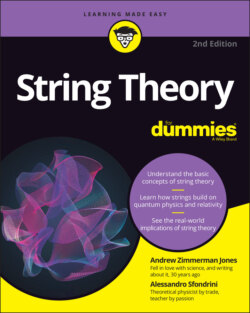Читать книгу String Theory For Dummies - Andrew Zimmerman Jones - Страница 48
A particle of gravity: The graviton
ОглавлениеThe Standard Model of particle physics explains electromagnetism, the strong nuclear force, and the weak nuclear force as fields that follow the rules of gauge theory. Gauge theory is based heavily on mathematical symmetries. Because these forces are quantum theories, the gauge fields come in discrete units (quantum means “how much” in Latin) — and these units actually turn out to be particles in their own right, called gauge bosons. The forces described by a gauge theory are carried, or mediated, by these gauge bosons.
For example, the electromagnetic force is mediated by the photon. When gravity is written in the form of a gauge theory, the gauge boson for gravity is called the graviton. (If you’re confused about gauge theories, don’t worry too much — just remember that the graviton is what makes gravity work and you’ll know everything you need to know to understand their application to string theory.)
Physicists have identified some features of the theoretical graviton so that, if it exists, it can be recognized. For one thing, the particle is massless, which means it has no rest mass — a graviton is always in motion, and that probably means it travels at the speed of light (although in Chapter 20 you find out about a theory of modified gravity in which gravity and light move through space at different speeds).
Another feature of the graviton is that it has a spin of 2. (Spin is a quantum number indicating an inherent property of a particle that acts kind of like angular momentum. Fundamental particles have an inherent spin, meaning they interact with other particles like they’re spinning even when they aren’t.)
A graviton also has no electrical charge. It’s a stable particle, which means it won’t decay.
So physicists are looking for a massless particle moving at an incredibly fast speed, with no electrical charge and a quantum spin of 2. Even though the graviton has never been discovered by experiment, it’s the gauge boson that mediates the gravitational force. Given the extremely weak strength of gravity in relation to other forces, trying to identify a single graviton is an incredibly hard task. (It is, however, possible to identify the gravitational waves created by many gravitons, which was done very recently, as you find out in Chapter 6.)
The possible existence of the graviton in string theory is one of the major motivations for looking toward the theory as a likely solution to the problem of quantum gravity.
